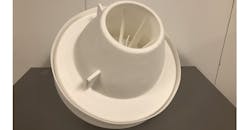Volvo Trucks using 3D printing in manufacturing at NRV plant
Volvo Trucks North America is utilizing 3D printing to produce tools and fixtures used in the manufacturing process at its New River Valley (NRV) plant in Dublin VA, where its trucks for the North American market are built.
The company says the implementation of 3D–printed manufacturing tools enables quicker production and continuous quality improvements.
“Volvo Trucks began exploring the use of 3D technology with a prototype approach, identifying opportunities to improve quality in the manufacturing process,” said Franky Marchand, vice president and general manager of NRV. “Several years later, we can now say that 3D printing has become an integral component to our manufacturing processes and culture at NRV.”
3D printing capabilities have improved quality and precision by printing exact copies from models, Volvo said. The technology effectively eliminates error, increasing the chances of first-time-through (FTT) production of assembly tools and fixtures, streamlining the manufacturing process and enabling customers to receive end products quicker.
Adam Crowder, manager of advanced manufacturing technology at NRV, is leading a global manufacturing-focused network representing 12 Volvo Trucks’ plants around the world, collaborating to develop new 3D printing applications and techniques for improved manufacturing.
After “years” of internal exploration with 3D printing technology and fine-tuning, there are now more than 500 manufacturing tools and fixtures in use on the NRV shop floor produced using 3D printing, Volvo maintained. All of these parts were printed at the Volvo Innovative Projects lab at the Dublin facility. In the state-of-the-art lab, Volvo Trucks primarily uses selective laser sintering (SLS), a 3D printing technology that uses a laser to sinter powdered plastic material into a solid structure that is then tested and put into use in the manufacturing process.
Using SLS allows engineers to design parts by drawing the end product, putting it in the machine and leaving it to print in a matter of hours during a workday or overnight, cutting down on the number of hours spent building parts through traditional tooling methods. The use of this technology also increases flexibility in manufacturing, reducing the wait for new parts from vendors by simply printing them in-house, Volvo said. These capabilities therefore reduce inventory expenses as well, eliminating space needed to house traditionally produced tools, driving costs down in end products for customers.
“While the technology has only been in use for a handful of years, it is already proving to be a valuable component of the manufacturing process at NRV, significantly saving production time and parts costs and continually improving quality,” said Crowder.
Volvo Trucks used 3D printing technology to develop a one-piece diffuser used in the paint atomizer cleaning process, which the company claims saved more than $1,000 per part, as well as eliminating the need for a multiple piece component. Spare parts also were produced for the 20 that were created so they can easily and quickly be replaced should wear occur.
Additional examples of 3D-printed parts in use by Volvo Trucks include:
- Roof seal gauges
- Fuse installation platens
- Drilling fixtures
- Brake piston gauges
- Vacuum drill ducts
- Brake valve fitting gauges
- Hood drilling fixtures
- Power steering adapter holders
- Luggage door gap gauges
- Luggage door pins
“The NRV facility is dedicated to exploring these new technologies to further improve efficiency and quality in our manufacturing and deliver the best products to our customers in a timely manner,” Marchand said. “Thanks to the collaborative effort of the entire team around the globe, we are able to accomplish that goal through 3D printing.
“We plan to continue to advance this technology to benefit our customers, saving them time and money.”
